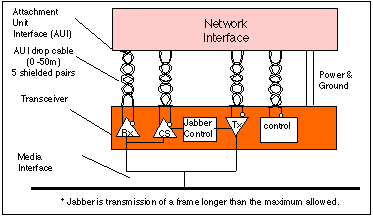
The Medium Access Control (MAC) transceiver [1] contains the electronics to allo a network interface to send and reciev using an Ethernet cable. The unit contains a line driver (the transmitter), a line receiver (the receiver), a carrier detect circuit (used to sense whether the cable is in use, and colisions) and control electronics to ensure correct operation of the device.
The IEEE added a number of additional control signals to the AUI cable, which although are often present, are now seldom used.

The transceiver control contains the necessary electronic circuits to :
This circuit is used to detect the presence of a signal on the media prior to transmission using CSMA/CD. This is used to detect when a collision occurs. When there is data waiting to be sent, each transmitting NIC also monitors its own transmission. If it observes a collision (excess current above what it is generating, i.e. > 24 mA for coaxial Ethernet), it stops transmission immediately and instead transmits a 32-bit jam sequence.
To ensure that all NICs start to receive a frame before the transmitting NIC has finished sending it. Ethernet defines a minimum frame size (i.e. no frame may have less than 46 bytes of payload). The minimum frame size is related to the distance which the network spans, the type of media being used and the number of repeaters which the signal may have to pass through to reach the furthest part of the LAN. Together these define a value known as the Ethernet Slot Time, corresponding to 512 bit times at 10 Mbps. The CD circuit MUST be monitored during this interval, although
This circuit can be also monitored for the remainder of the frame. The same circuit is used detect excess current on the media following a collision, hence triggering back-off and retransmission.
The interfaces allow external transceivers (e.g., copper or fibre optic transceivers) to be added to NICs and Ethernet switches.
A 10 Mbps Ethernet Transceiver is connected to the Attachment Unit Interface (AUI) port of a network interface card, which is a 15-pin D-type connector. The port is connected with the transceiver using an AUI drop cable. This AUI cable consists of 5 pairs of twisted copper wires each covered by an individual screen. The cable has an AUI connector at each end and may be up to 50 meters in length (25m in some specific cases). (The Belden part number for this type of cable is 9901.)
Transceivers and Modular Interfaces for Fast and GB Ethernet
A similar modular transceiver also exist when using higher speed Ethernet, e.g. the MII for Fast Ethernet and the GBICs used for Gigabit Ethernet. Each transceiver interface is designed to operate at one speed only and can not support transceivers designed for a different speed.
A transmitter may attempt to send more than the permitted frame size. In practice this can only arise through a hardware or software fault. Even so, since such errors have been observed on real systems, they must be guarded against. This is particularly significant since excessive jabber can very significantly reduce the performance of an Ethernet LAN.
The way chosen to prevent Jabber, is for the transceiver to count the number of bytes sent. If this number rises above the maximum allowed, a jabber control circuit forces the transceiver to terminate the frame, stopping the node from sending more data.
A transceiver was originalled called a "Medium Access Unit" (MAU).
Watch this:
See also: